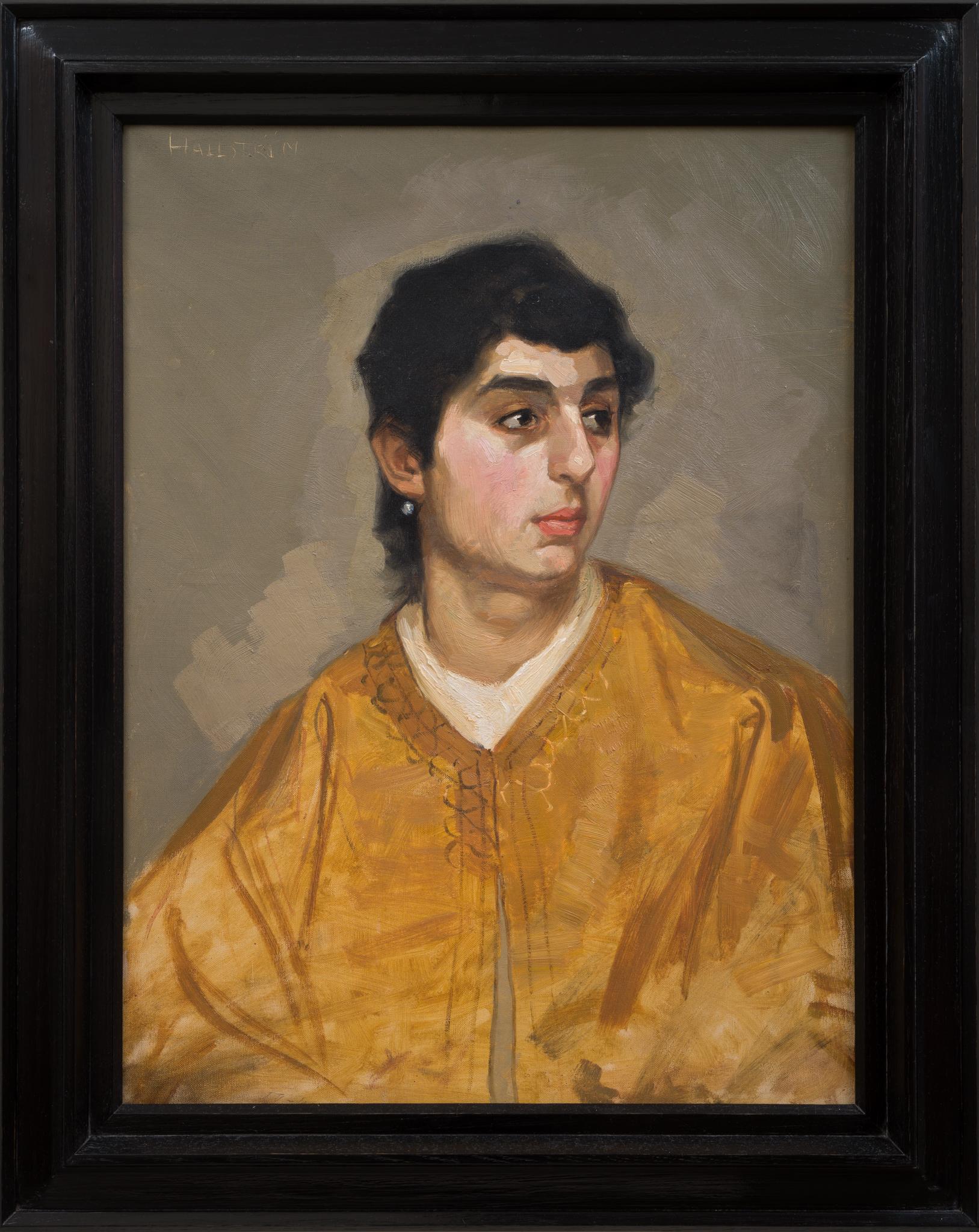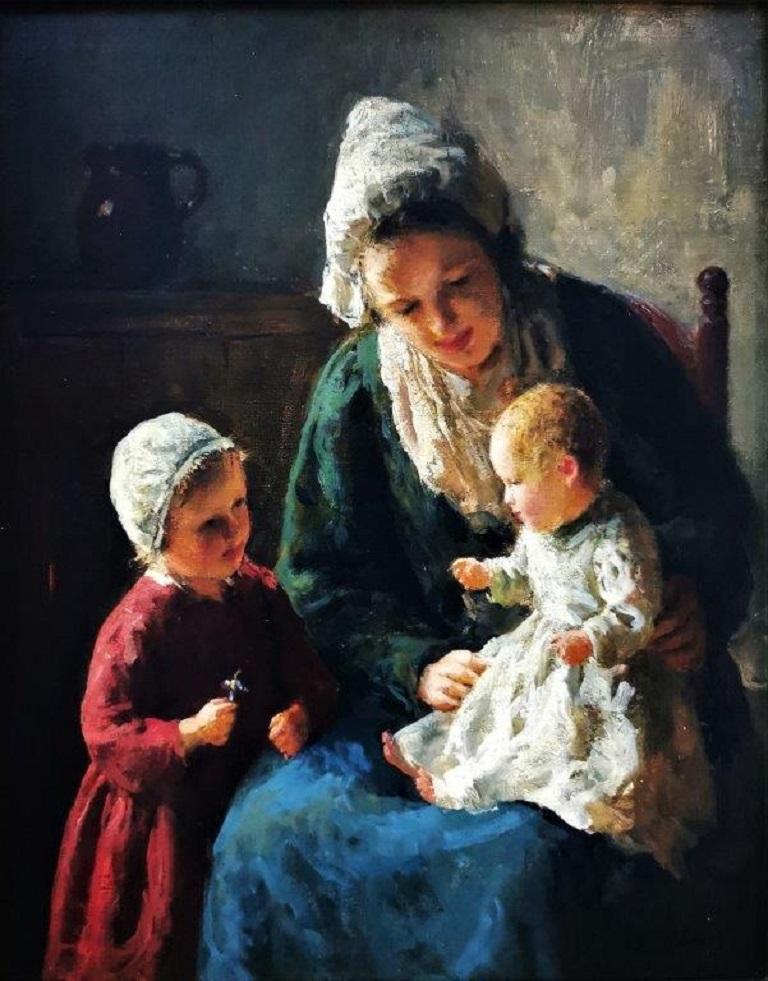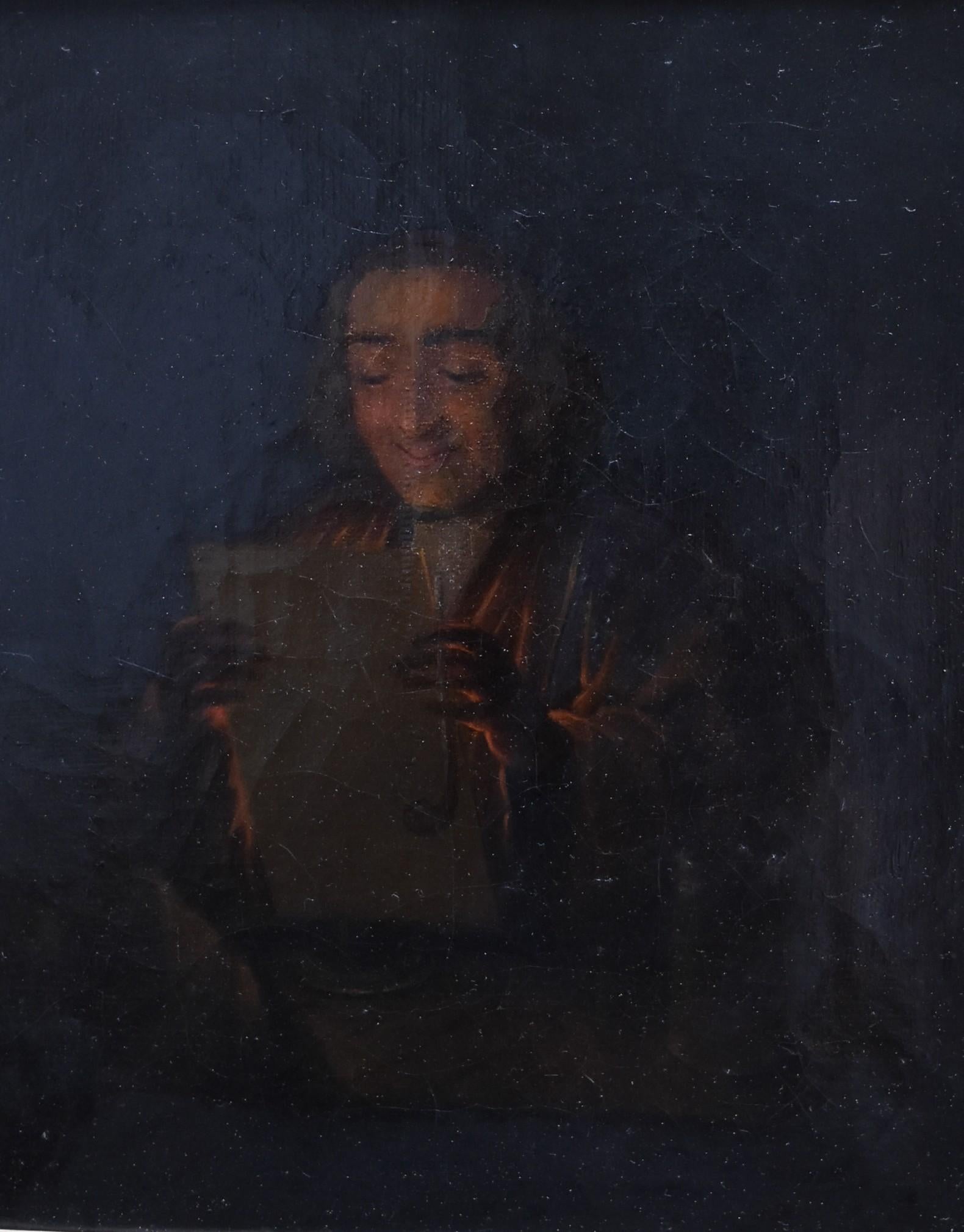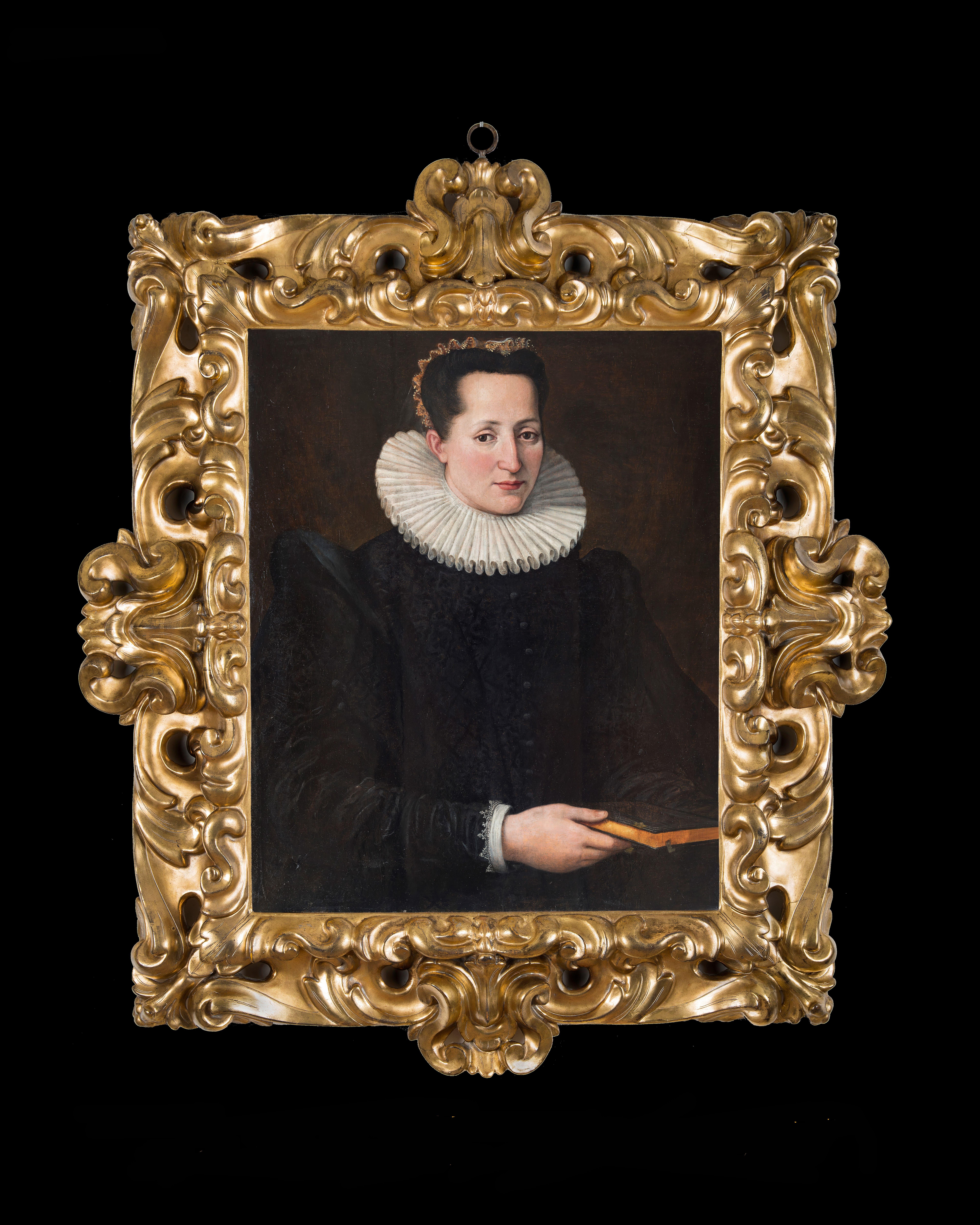Items Similar to P Deltour (?), An artist and his models in the workshop, 1879, oil on canvas
Want more images or videos?
Request additional images or videos from the seller
1 of 16
UnknownP Deltour (?), An artist and his models in the workshop, 1879, oil on canvas1879
1879
About the Item
P Deltour (?) French school of the 19th century
The artist with his model and friend in his workshop
Oil on canvas
Signed "P Deltour" (?) and dated 1879 on the lower, an indistinct inscription on the lower left
61 x 50 cm
In a modern frame : 69 x 58 cm
Old and very important restorations in the left part, inpaintings and traces of a repaired large tear in the middle left part. It has been relined.
The main sitter's face has been repainted and is no more original.
The subject and the treatment in details of a painter interior are really charming and original. The main sitter, a painter is absorbed in the contemplation of his last creation, perhaps a portrait of the woman on its side, who seems to have been nude just the moment before..... while one of his friend shows no interest to what's happening around him.
Unfortunately the condition of this painting is quite poor, the remaining untouched parts - mainly in the right part - are really well painted, it's a pity the left part had to be so rudely restored.
It's still quite charming when seen from distance and has to be hung with a lighting adapted to give the best of this painting.
- Creation Year:1879
- Dimensions:Height: 24.02 in (61 cm)Width: 19.69 in (50 cm)
- Medium:
- Movement & Style:
- Period:
- Condition:
- Gallery Location:Paris, FR
- Reference Number:
About the Seller
5.0
Platinum Seller
These expertly vetted sellers are 1stDibs' most experienced sellers and are rated highest by our customers.
Established in 2018
1stDibs seller since 2019
209 sales on 1stDibs
Typical response time: <1 hour
- ShippingRetrieving quote...Ships From: Paris, France
- Return PolicyA return for this item may be initiated within 14 days of delivery.
More From This SellerView All
- Dutch school 19th century, A philosopher reading, oil on canvasLocated in Paris, FRDutch school 19th century, A philosopher reading, oil on canvas 27 x 22 cm In a modern frame : 36.5 x 32 cm Recently restored and cleaned, some small inpaintings, thinness of the...Category
1870s Romantic Interior Paintings
MaterialsOil
- J J A Lecomte du Nouÿ (1842-1923) An oriental street, oil sketchBy Jean-Jules-Antoine Lecomte du NouÿLocated in Paris, FRJean-Jules-Antoine Lecomte du Nouÿ (1842-1923) An oriental street oil on canvas 11.5 x 14 cm no signature In good condition, canvas without stretcher,...Category
1890s Romantic Figurative Paintings
MaterialsOil
- French Romantic School, 19th Century, Portrait of a man, oil on paperLocated in Paris, FRFrench Romantic School, 19th Century Portrait of a man, a selfportrait ? oil on paper 17.5 x 12 cm oval Framed under glass : 43 x 34.5 cm This rather mysterious portrait is perhaps a self-portrait of the artist who painted it. This is suggested by the three-quarter pose and the gaze fixed on the viewer. What this man seems to be staring at is himself. Similarly, the model's appearance is reminiscent of the image of the romantic, bohemian, tortured artist. It's also very interesting that he used a range of dark colours to reinforce this idea of melancholy. It has been suggested that this small oil on paper is close to the art of François Bonvin (1817-1887) and Théodule Ribot...Category
1860s Romantic Portrait Paintings
MaterialsOil
- French Romantic School, 19th Century, Manly head of bearded man, oil on canvasLocated in Paris, FRFrench Romantic School 19th Century Manly head of bearded man oil on canvas 46 x 37.8 cm In fairly good condition, some inpaintings visible under UV light, mainly in the backgrounds ...Category
1850s Romantic Portrait Paintings
MaterialsCanvas, Oil
- Roger Cortet (1910-1978) Still-life with a white sculpture, oil on canvas signedBy Roger CortetLocated in Paris, FRRoger Cortet (1910-1978) Still-life with a white sculpture Oil on canvas Signed lower right 64 x 80 cm Framed : 70 x 85.5 cm There is a small but inconspicuous hole in the frame groo...Category
1930s Art Deco Still-life Paintings
MaterialsOil
- French school circa 1930, Portrait of a young man with blue eyes, oilLocated in Paris, FRFrench school circa 1930 Portrait of a young man with blue eyes Oil on cardboard panel 27 x 21.5 cm Bears a signature (illegible) upper right Framed : 34.5 x 29.5 cmCategory
1930s Modern Portrait Paintings
MaterialsOil
You May Also Like
- Portrait of a Girl With a Pearl EarringLocated in Stockholm, SEThis exquisite portrait by Gunnar Hallström, titled "Portrait of a Girl with a Pearl Earring" invites viewers into a moment of quiet introspection. Painted in the 1920s, the subject ...Category
1920s Romantic Portrait Paintings
MaterialsCanvas, Oil
- "The Beautiful Story”, period Belgian interior, romantic portraiture, oil/canvasBy Edward Antoon PortieljeLocated in Nutfield, SurreyThis is an original unique oil painting by the artist, Edward Antoon Portielje, a late nineteenth-, early twentieth-century Belgian painter from Antwerp, who showed an interest in se...Category
19th Century Romantic Portrait Paintings
MaterialsCanvas, Oil
- "Mother and Daughters”, Dutch Interior scene, Romantic style, oil on canvasBy Bernard PothastLocated in Nutfield, SurreyBernard Pothast (1882-1966) Although born in Belgium in 1882, Bernard Pothast was the...Category
20th Century Romantic Portrait Paintings
MaterialsOil, Canvas
- The wedding Dress, Large Scale French 1950s Society PortraitLocated in Cotignac, FRA large scale 1950s French society portrait by Anne-Marie Joly. The painting is signed and dated bottom right. Presented in a magnificent carved wood...Category
Mid-20th Century Romantic Portrait Paintings
MaterialsCanvas, Oil
- Ritratto di NobildonnaLocated in Balerna, TISanti di Tito Ritratto di Nobildonna Olio su tavola, Sec. XVI, cm 74x61; con cornice 116x100x9 Con procedere degli studi su Santi di Tito, del quale è stata recentemente precisata la nascita fiorentina , si viene sempre più definendo come non solo una delle personalità più interessanti della scena artistica fiorentina, ma anche come il più interessante ritrattista cittadino della seconda metà del Cinquecento. L'attribuzione di questo ritratto al pittore, che nell'impresa dello Studiolo di Francesco I fu uno dei maggiori innovatori fra i giovani riuniti da Vasari e Borghini, appare subito evidente per l’inconfondibile disegno ovale e fermo del volto, reso con un incarnato compatto dai toni rosati che si accende di naturalistiche notazioni epidermiche ma anche di una puntuale figurazioni degli elmenti decorativi dell’abito e dell’acconciatura. Sempre coerente con i modi pittorici di Santi è poi la pittura compatta con la quale vengono definiti i piani semplificati del volto delle donna, che conservano una notazione di luce e di naturale sensibilità in linea con i dettami controriformati dei quali il pittore fu uno dei più fedeli osservanti nella scena fiorentina. Sempre tipica di Santi di Tito è poi la ferma e volumetrica rappresentazione del torso e dell’abito definito nei piccoli intagli della stoffa ma allo stesso tempo semplificato nei volumi delle maniche e del busto. Ancora di santi ci sembra la notazione luministica con la quale è rilevato il disegno dell’abito attraverso stesure compatte ma sottili e trasparenti, oppure è resa la gorgiera bianca che aggiunge una luce netta all’intero dipinto. Una simile scelta pittorica appare nel Ritratto di Guido Guardi coi figli, esposto alla mostra Il Cinquecento a Firenze, (Palazzo Strozzi, 21 settembre 2017 – 21 gennaio 2018, n. IV. 5, pp. 156-157), dove, pur in un ritratto maschile, Santi di Tito usa la medesima cifra formale nella resa dei volti e delle gorgiere. Pur nell'attenzione alle caratteristiche fisionomiche, Santi di Tito conserva, infatti, una cifra disegnativa sempre evidente e riconoscibile pur col passare degli anni, un carattere stilistico che sostiene, con volumi saldi, ogni sua differente prova pittorica. Ne sono un esempio dipinti quali il Ritratto di donna con Figlia, già in collezione Koelliker2, oppure il Ritratto di Lucrezia (Emilia) e Sinibaldo di Niccol Gaddi3, tutti databili agli anni settanta del Cinquecento proprio per la stereometrica definizione delle forma. Col passare degli anni, invece, tale carattere di ascendenza bronzinesca sembra cedere sempre più in favore di una pittura più morbida e sensibile, chiamata a raggiungere esiti di naturalezza sempre maggiore. Dipinto emblematico per seguire tale percorso rimane il già citato Ritratto di Guido Guardi con i figli , dove Santi di Tito ha effigiato il capofamiglia subito dopo il suo ritorno da Roma, fra il 1564 e il 1568, al tempo in cui il Guardi commission al pittore anche una pala con una Natività per la cappella di famiglia a San Giuseppe. L’uomo, seduto su uno scranno, sembra rimandare per la posa arcaizzante alla ritrattistica di primo Cinquecento, alla quale Santi di Tito s’ispira anche per le pieghe frante ma scultoree dell’abito. Sulla stessa tavola, probabilmente verso la fine degli anni settanta del Cinquecento, il pittore venne chiamato ad aggiungere le effigi di figli, quando probabilmente l’opera era già in cornice, e lo fece con una pittura più svolta e libera, in modo da raggiungere effetti naturalistici di maggiore sensibilità. Anche nel Ritratto di donna in esame, i volumi saldi e potenti della figura spiccano sul fondo monocromo della parete con un’evidenza che farebbe pensare alle figure eseguite dalla fine degli anni Settanta del Cinquecento, al pari, appunto dei due figli di Guido Guardi. Nato a Firenze nel 1536, Santi di Tito si form prima da Bastiano da Montecarlo per passare poi dal Bronzino, del quale conserv la preferenza per volumi luminosi e torniti, a cui aggiunse un'attenzione per la chiarezza compositiva e il naturalismo richiesti dai dettami della Controriforma, che lo portarono a guardare allo stile di Scipione Pulzone...Category
16th Century Italian School Portrait Paintings
MaterialsOil, Panel
- Ritratto di Gentiluomo con caneLocated in Balerna, TIBartolomeo Passerotti ( Bologna 1529 – 3 giugno 1592) Ritratto di Gentiluomo con cane Olio su tavola, Sec. XVI, cm 84x69; con cornice 101x87 // Bartolomeo Passerotti (Bologna 1529...Category
16th Century Italian School Portrait Paintings
MaterialsOil, Panel
Recently Viewed
View AllMore Ways To Browse
Antique Workshop
1879 Paintings
Antique Artist Model
19th Century Artist Model
Unknown Artists Original Oil
Large Model Canvas Painting
Model 1879
French Romantic Portraits
Modern Portrait Of A Woman Oil On Canvas
19th French Portrait Woman
Dior Lady Show
18th Century Portrait American
1800 Oil Painting Portrait
Red Hair Woman Portrait
Lady With Hat Painting
Flemish Oil Portrait
17th French Portrait Oil
Gilt Framed Woman Portrait Oil Paintings





